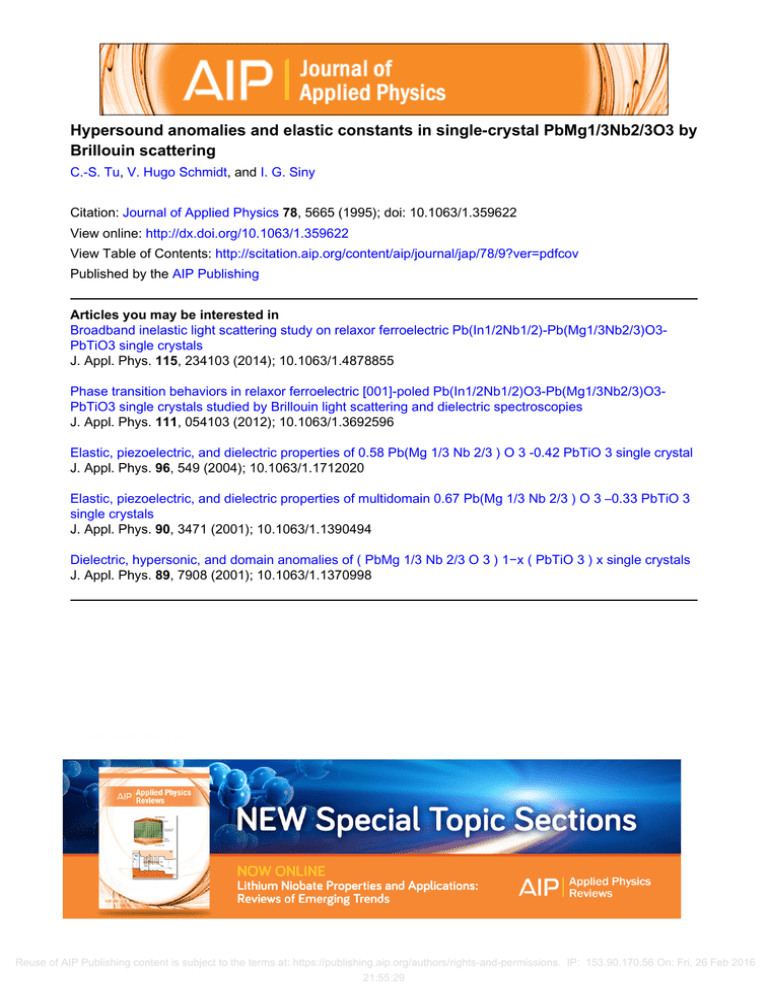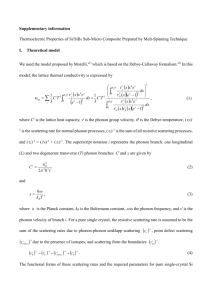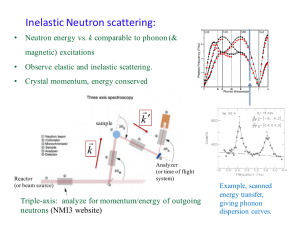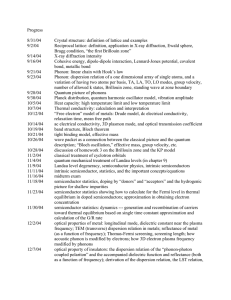Hypersound anomalies and elastic constants in single‐crystal PbMg1/3Nb2/3O3 by Brillouin scattering
advertisement

Hypersound anomalies and elastic constants in single‐crystal PbMg1/3Nb2/3O3 by Brillouin scattering C.‐S. Tu, V. Hugo Schmidt, and I. G. Siny Citation: Journal of Applied Physics 78, 5665 (1995); doi: 10.1063/1.359622 View online: http://dx.doi.org/10.1063/1.359622 View Table of Contents: http://scitation.aip.org/content/aip/journal/jap/78/9?ver=pdfcov Published by the AIP Publishing Articles you may be interested in Broadband inelastic light scattering study on relaxor ferroelectric Pb(In1/2Nb1/2)-Pb(Mg1/3Nb2/3)O3PbTiO3 single crystals J. Appl. Phys. 115, 234103 (2014); 10.1063/1.4878855 Phase transition behaviors in relaxor ferroelectric [001]-poled Pb(In1/2Nb1/2)O3-Pb(Mg1/3Nb2/3)O3PbTiO3 single crystals studied by Brillouin light scattering and dielectric spectroscopies J. Appl. Phys. 111, 054103 (2012); 10.1063/1.3692596 Elastic, piezoelectric, and dielectric properties of 0.58 Pb(Mg 1/3 Nb 2/3 ) O 3 -0.42 PbTiO 3 single crystal J. Appl. Phys. 96, 549 (2004); 10.1063/1.1712020 Elastic, piezoelectric, and dielectric properties of multidomain 0.67 Pb(Mg 1/3 Nb 2/3 ) O 3 –0.33 PbTiO 3 single crystals J. Appl. Phys. 90, 3471 (2001); 10.1063/1.1390494 Dielectric, hypersonic, and domain anomalies of ( PbMg 1/3 Nb 2/3 O 3 ) 1−x ( PbTiO 3 ) x single crystals J. Appl. Phys. 89, 7908 (2001); 10.1063/1.1370998 Reuse of AIP Publishing content is subject to the terms at: https://publishing.aip.org/authors/rights-and-permissions. IP: 153.90.170.56 On: Fri, 26 Feb 2016 21:55:29 Hypersound anomalies and elastic constants PbMgI,3Nbu,0, by Brillouin scattering in single-crystal C.-S. Tu,~) V. Hugo Schmidt, and I. G. Sinyb) Department of Physics, Montana State University, Bozeman, Montana 59717 (Received 28 December 1994; accepted for publication 5 July 1995) The longitudinal (LA) and transverse (TA) Brillouin spectra along [OOl] phonon direction have been measured as a function of temperature (50-475 K) in single-crystal PbMg,,sNbZsOs with scattering angles 0,= 180” and 32.520.2”. The Brillouin frequency shift with decreasing temperature shows a broad softening anomaly for both LA and TA phonon modes. For 19,=180”, a gradual growth in damping with maximum near 270 K is observed and is attributed to order parameter fluctuations. An additional Landau-Khalatnikov maximum is also observed at T,-212 K. This anomaly implies a rapid growth of ferroelectric ordering near T, and is consistent with the earlier linear birefringence results reported by Westphal et al. The elastic stiffness and compliance constants, Cf, , C&, and & are also determined between 200 and 370 K. 0 1995 American Institute of Physics. I. INTRODUCTION Relaxor ferroelectrics generally mean the complex perovskites with ABO,-type unit cell and are crystals in which unlike-valence cations belonging to a given site (A or B) are presented in the correct ratio for charge balance, but are situated randomly on these cation sites. These randomly different cation charges give rise to random fields. These random fields tend to make the phase transitions “diffuse” instead of sharp as in normal ferroelectrics.’ The physical properties of relaxor ferroelectrics near transitions also depend on the cation ordering degree. The ordering tendency depends on several things such as method of crystal growth, cation valence, and thermal treatment (e.g., quenching or annealing). Another complication is the aging effect which can span a wide time scale in a nonlinear manner.’ In the supposedly disordered PbMg,,,Nbu303 (PMN) crystal, and unexpected microstructure on a nanometric length scale with 1: 1 B’:B” cation ordering was reported.’ Such 1:l ordering, when charge neutrality requires 1:2 stoichiometry, implies locally charged regions causing fields which can induce order parameter fluctuations. Recent measurements indicate only a 5% tendency toward 1:l ordering in these microregions. Three recent models for relaxor PMN have been proposed, namely the random field (RF) model of Westphal et al.,4 the dipolar glass model of Viehland et al.,5 and the structural model by Mathan et a1.6 This last model indicates an average cubic structure even at 5 K, but with some 20% of the material in noncubic FE microdomains near 100 A size. The RF model postulates random electric fields originating in a peculiarity of PMN’s structure (local nonstoichiometric order causing local net charge), resulting in microdomains polarized along eight (111) directions. The authors also postulate that the cubic anisotropy corresponding to these eight directions is low enough so that the random fields %-esent address: Dept. of Physics, Fu-Jen University, Taipei, Taiwan. “No~ returna to A. F. Ioffe Physical Tech. Inst. RAS, St. Petersburg, Russia. can suppress the FE transition.4 In the dipolar glass model, the “pseudospins” are nanometer-sized superparaelectric clusters which correspond to the microdomains in the RF model. The dipolar glass model assumes these clusters can flip at higher temperature, but freeze into a random configuration at lower temperature. II. EXPERIMENT In this study, a single-crystal of PbMg113Nb2/303 with size of 5.37X4.77X2.82 (mm)3 was used for Brillouin scattering with scattering angles 13,=180” and 32.5t0.2”. Here f3, is the angle between incident and scattered wave vectors inside the crystal. In order to reduce the low-lying frequency mode of the Raman spectra, a narrow-band (1 A) interference filter was used. The sample which was used for previous Raman scattering7 was oriented so as to allow observation of [OOl] phonons for both scattering angles. The light source was a Lexel Model 95-2 argon laser with X=514.5 nm at a power of - 100 mW. Scattered light was analyzed by a Burleigh five-pass Fabry-Perot interferometer. A Leybold RGD-210 closed-cycle helium refrigerator was used with a Lakeshore DRC-9 1C temperature controller. The temperature was measured within +O.Ol K by a calibrated silicon diode thermal sensor. The sample was heated from 50 to 475 K by steps and results were found to be reproducible. For determination of natural-phonon half width, the natural-phonon spectrum, and the instrumental function were assumed to have the Lorentz distribution, and the broadening due to collection optics was assumed to have rectangular distribution. In this case, the natural-phonon half-width Svpr., is given by8 hph= (S&,- 82m8)“2- Sv&t, (1) where &,I,~, N,,, , and ayangrepresent the observed, instrumental, and collection optics half widths, respectively. The half width of the Rayleigh line from fused quartz (which had approximately the assumed Lorentz shape) was taken as the instrumental broadening SY,,, -0.02 FSR. Here FSR means the free spectral range, 17.035 GHz. The Brillouin line 5665 Q 1995 American Institute of Physics 0021-8979/95/78(9)/5885/4/$8.00 J. Appl. Phys. 78 (9), 1 November 1995 Reuse of AIP Publishing content is subject to the terms at: https://publishing.aip.org/authors/rights-and-permissions. IP: 153.90.170.56 On: Fri, 26 Feb 2016 21:55:29 (b) 0 100 200 300 400 500 Temperature (K) 100 200 300 FIG. 2. (a) Frequency shift Au and (b) half-width c!$, vs temperature of the LA[OOl] phonons for I$= 180”. (c) The real part of dielectric permittivity vs temperature at four different frequencies. The dashed line indicates the ferroelectric phase transition temperature T,--212 K. 400 Channels FIG. 1. Anti-Stokes and Stokes components of the LNOOI] Brillouin spectra for temperatures near the maximum damping for 0, = 180”. The frequency interval between the two Rayleigh peaks is 17.035 GHz (FSR). broadening &,,s due to finite collection angle @ r, is described by a well-known formula’ which to second order in seap is ~%ng -= c0t( e/2) soap AlJ 2 -- ( sea,,J2 8 ’ (2) where B is the scattering angle and AY is the Brillouin frequency shift. III. RESULTS AND DISCUSSION Actual LA[OOl] phonon spectra of the anti-Stokes and Stokes Brillouin components for 0, = 180” are shown in Fig. 1. According to the calculations of Ref. 10, there is no transverse mode to be expected in this configuration. The data shown here are for several temperatures near the maximum value of half width. Both frequency shift and half width exhibit a strong temperature dependence. Figure 1 also shows that the background of the Brillouin spectra changes drastically with temperature. Since Brillouin spectra are sensitive to the central peak near the brillouin zone center, this background anomaly implies an evolution of the central component. The accumulated data for backscattering (0, = 180”) are shown in Fig. 2. Here, the Lorentz profile was used to fit the phonon spectra, from which the frequency shift and half 5666 J. Appl. Phys., Vol. 78, No. 9, 1 November 1995 width were obtained. Figure 2 data indicate that a broad phonon softening occurs starting at T>475 K and reaches a minimum near 270 K, associated with a broad maximum in damping. The temperature dependences of velocity and damping look like reflections of each other. Such a growth of damping over a wide temperature range reveals that order parameter fluctuations are the dominant dynamic mechanism. The dynamic fluctuation contribution is a characteristic of an #p-type quadratic coupling (electrostriction),” squared in order parameter and linear in strain. However, a step-like frequency softening typical for #p-type coupling is not observed in this case.” Beside this broad damping background, there is an additional sharp damping peak near 212 K which can be connected with the typical LandauKhalatnikov maximum. For comparison, frequencydependent dielectric measurements were also carried out by ourselves and are presented in Fig. 2(c). What are the origins of these two damping peaks in PMN? The temperature dependence of the linear birefringence An in PMN under an external electric field suggests an equilibrium phase transition temperature T, in the absence of a random field, 200 K<T,<234 K.4 In addition, by fitting the time dependence of the linear birefringence with two different exponents p below and above 212 K, Westphal et al. propose that the Curie temperature of PMN is T,--2 12 K.4 Viehland ef al. also claim that the freezing temperature is Tf-217 K below which a dramatic change of the relaxation time distribution is observed which is interpreted as a result of a long-range correlation of polar microdomains. Recent quasielastic-neutron scattering*2 on PMN supports the above Tu, Schmidt, and Siny Reuse of AIP Publishing content is subject to the terms at: https://publishing.aip.org/authors/rights-and-permissions. IP: 153.90.170.56 On: Fri, 26 Feb 2016 21:55:29 $ 12.4 g 12.2 @ 12.0 h u. tJWt1 (4 0 0 0.2 0 0“&$ o a oo” 00 0’0 0% 0 e 0BOO *O& Yg+f$$f 11.8 randomly placed cations in complex relaxor ferroelectrics. The longitudinal LA[OOl] and transverse TA[OOl] phonon data for angle 9,=32.5+0.2” are shown in Fig. 3. A phonon frequency softening is also observed for both LA and TA phonon modes, with a broad minimum at T-270 K. According to Eq. (2), the relative error in damping for the small-angle scattering is much larger than for backscattering, and is comparable to both Svph and Gpmst, so the naturalphonon half-width 6pphfor this small angle cannot be determined accurately. H s2 % (b) 40 o. .o”~.a 0 onw 0 H & 8.2 5 (4 IV. CALCULATIONS TA[OOi] 8.0 Ooo “/ o -=-?T>j& Jo’ 0o lf OF ELASTIC a 0 7.8 1 Pv~uicrijk14j41uk 100 200 300 CONSTANTS Brillouin light scattering is a powerful tool to determine the elastic stiffness and compliance constants. In general, the equation of motion for a phonon propagating in a piezoelectric material can be written as a 3X3 eigenvalue equation16 00 -b ti 5 0.8 k I” iii s P F % I eaijejkl 73 rijkl=Cckl+ 3 (3) la 500 400 Temperature (K) where Vq and Ui are the phonon velocity and displacement (polarization), respectively; is the piezoelectricahy stiffened elastic modulus;16 p is the sample density; C$[ is the elastic stiffness constant at constant electric field; eaij is the piezoelectric stress constant; .$a. is the permittivity at constant strain; and qj (or qr) is the projection of the unit phonon wave vector along the ith axis. The high-temperature phase in PMN is cubic with point group m3m whereas below 200 K, a small portion exhibited trigonal distortion as observed by Shebanov et ~1.‘~ Thus, we can consider PMN as cubic for T3200 K. In other words, for Ts200 K, all elements of e,.ij are zero18 and the nonvanishing Cck/, in Voigt notation, are Cfi , c?2:,, and Cf4, rijkl FIG. 3. (a) Frequency shift Av and (b) half-width Sv,,, vs temperature of the LA[oOl] phonons for /3,=32.5-+0.2’. (c) Frequency shift vs temperature of the TAfOOl] phonons. The dashed line is a guide to the eye. interpretations and shows that the correlation length is nearly temperature independent with a maximum value of 200 8, below -217 K. Since the Landau-Khalatnikov maximum is sensitive to the occurrence of FE ordering,’ we attribute this Landau-Khalatnikov maximum in PMN to the rapid growth of FE ordering at T,-212 K. The random field model4 proposes that the dielectric diffuse phase transition near 270 K is due to quenched random electric fields originating from charged compositional fluctuations at the B site of the ABOs structure.4 These random fields can suppress a long-range-order ferroelectric transition and generate order parameter fluctuations. Thus, one can expect that such random fields are responsible for the evolution of broad damping background with a maximum near 270 K [see Fig. 2(b)] and th e modification of $p-type frequency softening, i.e., a broad dip instead of a typical step-like anomaly. Similar acoustic anomalies, i.e., a broad damping maximum and a broad velocity dip, are also observed in Na,,Bi,,TiOs (NBT).13*14However, the usual Landau theory does not predict these anomalies.15 Such acoustic similarity between PMN and NBT seems to imply the importance of ~llqlql+C444343+C44q2q2-PV2 c444142+c124241 c44qlq3+cl2q3ql . 18 I.e., c;= cf2 cf2 0 0 0 cF2 c:, cf2 0 0 0 Cfl 0 0 0 CT2 c& 0 0 0 cf4 0 0 0 0 0 0 cf4 0 0 0 0 0 0 c& Here, the relations C& = Cf2 = Cf, and C &= C& = Cf4 have been used for the cubic case.‘* For an arbitrary phonon wave direction 4 in the crystal with cubic symmetry. Equation (3) gives a secular equation C12qlq2fC44q2ql C444*q1+C11q2q2+C44q3q3-PV2 c44q2q3+ CT, c12q3q2 cl2qlq3+c44q3ql c12q2q3 + c44q3q2 = 0. C4442q2+Cllq3q3+C44ww-PV2 (4) Tu, Schmidt, and Siny J. Appl.Phys., Vol. 78, No. 9, 1 November 1995 5667 Reuse of AIP Publishing content is subject to the terms at: https://publishing.aip.org/authors/rights-and-permissions. IP: 153.90.170.56 On: Fri, 26 Feb 2016 21:55:29 TABLE I. Elastic stiffness and compliance constants of PMN at several temperatures from two scattering angles &= 180” and 32.520.2”. From 6’,=32.5?0.2’ From 19,= 180” T(K) Cf,(lO” N/m’) 200 219 245 268 284 300 321 340 370 1.64 1.63 1.63 1.62 1.62 1.62 I .63 1.64 1.67 Cf’(l0” N/m’) Cfd(lOto N/m’) 1.52 1.49 1.48 1.49 1.47 1.49 1.49 1.49 1.55 s&(10-” 6.93 6.96 6.68 6.76 6.69 6.76 6.96 6.87 7.00 m2/N) 1.44 1.44 1.50 1.48 1.50 1.48 1.44 1.46 1.43 V. CONCLUSIONS This secular equation yields three eigenvalues which are associated with sound velocities of three phonon waves propagating in the same direction, and three mutually orthogonal eigenvectors which are the polarizations (displacement) of phonon. In our experimental situation, the measured phonon is along the [OOl] direction (4 11[001]),7 i.e., qs=l, 4, = q*=O. By solving the secular Eq. (4), one can obtain &*= cf,; pv&=c&. (5) Subscripts LA and TA represent the longitudinal and transverse acoustic phonon modes, respectively. Since the thermal strain AU& is almost zero below 400 K,’ one can use the density of PMN at room temperature, i.e., p=8.12X IO3 kg/m3,19 for calculation of elastic constants below 400 K. The relation between frequency shift and sound velocity is2’ (6) where X0 is the wavelength of the incident light in vacuum, and B is the scattering angle in the crystal. Substituting Eq. (6) into Eq. (.5), we have c:,=p( 2n~~p,;;2,)2~ Ct=pj 2nh$;2j)2i ferroelectrics. For instance, Cft is 2.35X 10” N/m2 for PbTiO, and 2.11 X IO” N/m2 for BaTiO, .20 However, the elastic stiffness constant C& of PMN is slightly greater than those of PbTiO, (Cf4 = 6.5 1 X 10 lo N/m2) and BaTiO, (Cf4=5.62X 10” N/m2)?’ (7) where Av,A and Ar+, are the longitudinal and transverse phonon frequency shifts, respectively. The temperature dependent refractive index n(r) is obtained from Ref. 21. The calculated values of Cy,, C,“,, and s & at several temperatures are listed in Table I. The error in these elastic constants is about 1.3%. Here the relation &= l/C,“, , has been used E 16 to obtain s44. As seen in Table I both elastic stiffness constants Cf, and C& show a slight softening around 280 K. The values of Cf, from I$= 180” and 13,=32.5+0.2” are in good agreement with each other. Since sound velocity is sensitive to scattering angle, we attribute the slight difference in Cy, to the determination error for small scattering angle. At room temperature, the elastic stiffness constant CF, of PMN is smaller compared to those of pure perovskite-type A broad phonon softening has been observed for both LA[OOl] and TA[OOl] phonon modes starting at T>475 K followed by a hardening around 270 K. For scattering angle e,= 180”, a strong broad damping background is observed and is attributed to order parameter fluctuations. Such fluctuations are attributed to random fields originating from random placed cations at the B site of the AB03 structure. An additional Landau-Khalatnikov maximum is also observed at T,-212 K and implies a rapid growth of FE ordering. In brief, the present Brillouin scattering results favor the random field model! The similarity between PMN and NBT implies that the random-cations-caused fluctuations play an important role in the acoustic anomalies of complex relaxor ferroelectrics. ACKNOWLEDGMENTS This work was supported in part by NSF Grant No. DMR-9017429 and DOE Equipment Grant No. FG059 lER79046. ’L. E. Cross, Ferroelectrics 76, 241 (1987). *A. D. Hilton, D. J. Barber, C. A. Randall, and T. R. Shrout, J. Mater. Sci. 25, 3461 (1990). 3S. B. Vakhrushev, A. A. Nabereznov, Y. P. Feng, S. K. Sinha, S. M. Shapiro, T. Egami, H. D. Rosenfeld, and D. E. Moncton, Bull. Am. Phys. sot. 39, 680 (1994). 4V. Westphal, W. Kleemann, and M. D. Glinchuk, Phys. Rev. Lett. 68, 847 (1992). ‘D. Viehland, M. Wuttig, and L. E. Cross, Ferroelectrics 120, 71 (1991). ‘N. de Mathan, E. Husson, G. Calvarin, J. R. Gavarri, A. W. Hewat, and A. More& J. Phys. Condens. Matter 3, 8159 (1991). 71. G. Siny and T. A. Smimova, Ferroelectrics 90, 191 (1989). *T. Hikita, J. Phys. Sot. Jpn. 53, 1513 (1984). ‘J. M. Vaughan, The Fubry-Perot Interferometer (Adam Hilger, Bristol and Philadelphia, 1989), pp. 341-344; H. G. Danielmeyer, J. Acoust. Sot. Am. 47, 151 (1970). ‘OR. Vacher and L. Boyer, Phys. Rev. B 6, 639 (1972). “W. Rehwald, Adv. Phys. 22, 721 (1973). “S. Vakhrushev, B. Kryatkovsky, A. Naberzhou, N. Okuneva, and B. Topervers, Ferroelectrics 90, 173 (1989). “C.-S. Tu, I. G. Siny, and V. H. Schmidt, Ferroelectrics 152, 403 (1994). 14C.-S. Tu, I. G. Siny, and V. H. Schmidt, Phys. Rev. B 49, 11550 (1994). “W. Yao, H. Z. Cummins, and R. H. Bruce, Phys. Rev. B 24,424 (1981); J. J. L. Horikx, A. F. M. Arts, J. I. Dijkhuis, and H. W. de Wijn, ibid. 39, 5726 (1989). 16E Dieulesaint and D. Royer, Elastic Waves in Solids (Wiley, New York, 1982), pp. 244-269. 17L. A. Shebanov, P Kaspostins, and J. Zvirgzds, Ferroelectrics 56, 1057 (1984). ‘*J. F. Nye, Physical Properties of Crystals (Clarendon, Oxford, 1957). “Landoh-Bomstein, New Series, Vol. IIV16a. edited by K.-H. Hellwege (Springer, Berlin, 1982). 2oZ. Li, M. Grimsditch, X. Xu, and S.-K. Ghan, Ferroelectrics 141, 313 (1993). 2’G. Bums and F. H. Dacol, Solid State Commun. 48, 853 (1983). 5668 J. Appl. Phys., Vol. 78, No. 9, 1 November 1995 Tu, Schmidt, and Siny Reuse of AIP Publishing content is subject to the terms at: https://publishing.aip.org/authors/rights-and-permissions. IP: 153.90.170.56 On: Fri, 26 Feb 2016 21:55:29





